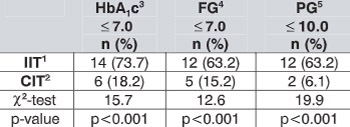Metabolic control and body mass index in patients with type 1 diabetes on different insulin regimens
DOI:
https://doi.org/10.17305/bjbms.2004.3456Keywords:
type 1 diabetes mellitus, insulin regimens, insulin resistanceAbstract
ABSTRACT
INTRODUCTION: Without sufficient insulin treatment, acceptable level of glycoregulation, avoidance of dislipoproteinaemia and maintaince of body mass is difficult to achieve in patients with type 1 diabetes mellitus (DM). On the other hand sometimes it is difficult to prevent weight gain, endogenous hyperlipidemia and iatrogenic insulin resistance.
AIM: To compare metabolic control indicators in patients with type 1 DM in patients treated conventionally to those on intensified insulin regimen.
MATERIAL AND METHODS: A sample of 52 persons with type 1 DM, without late complications and long duration of the disease, was selected. Among them 19 (36.5%) persons were treated with insulin in 4 or 5 doses, and 33 (63.5%) conventionally, in 2 doses. All the participants had biochemical indicators of metabolic control determined (glycosylated Hb, fasting and postprandial glycaemia, total cholesterol, triglycerides as well as lipoprotein fractions, HDLC and LDLC), body height (BH) and weight (BW) measured, body mass index calculated (BMI) and blood pressure measured (BP).
RESULTS: In the group treated conventionally we found significantly higher mean values of BMI as compared to those on intensified insulin treatment (23.2 ± 2.0 kg/m2, and 21.2 ± 1.2 kg/m2 respectively, p<0.01) and proportion of those with overweight was as well significantly higher (27.3% versus 0%, p =0.012). We noted higher mean values of systolic (134.2 ± 17.6 mmHg, versus 123.4 ± 12.7. p<0.05) and diastolic (83.2 ± 10.1, versus 74.0 ± 9.7, p<0.01) BP. Biohemical indicators of gly-coregulation were significantly worse with, at the same time, higher total dose of applied insulin (55.9 ± 8.5 IU, versus 46.3 ± 10.0 IU, p <0.01), and insulin units per kg of body weight (0.84 ± 0.11 IU/kg versus 0.77 ± 0.15 IU/kg, p<0.05).
CONCLUSION: Results indicate that intensified insulin treatment is more favourable variant of treatment, by which the certain level of insulin resistance, which might be present in patients treated with two higher insulin doses, is probably reduced. Therefore it improves metabolic outputs, blood pressure values and body mass index but also may have beneficial impact to economic aspect of insulin treatment as well.
Citations
Downloads

Downloads
Published
Issue
Section
Categories
How to Cite
Accepted 2018-04-05
Published 2004-02-20









